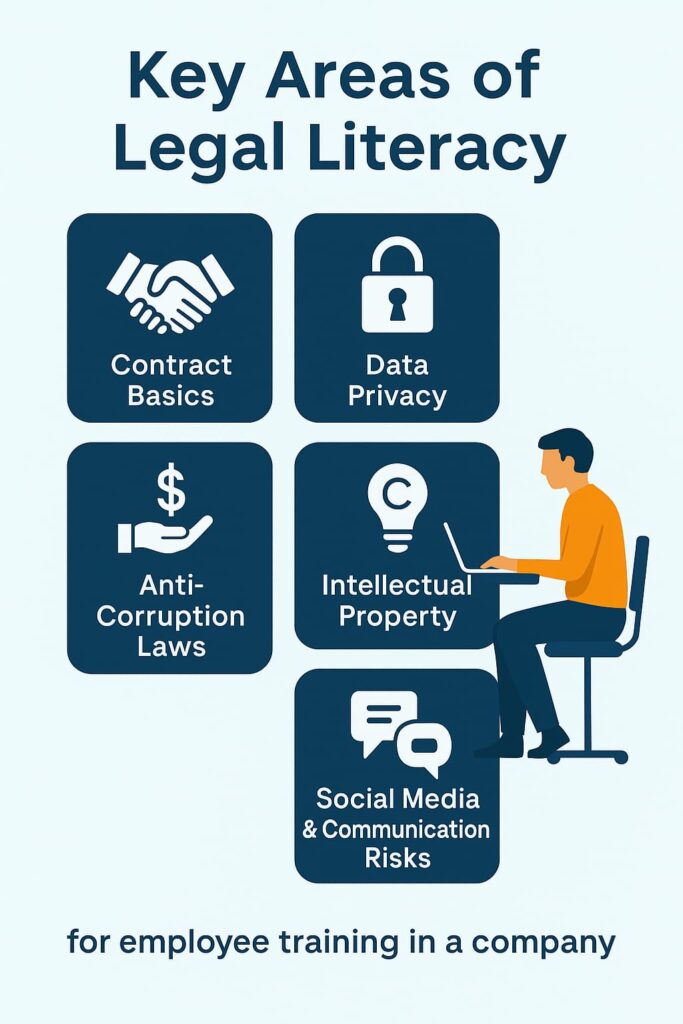Modern companies operate in a legal landscape that is more complex, demanding, and unforgiving than ever. From data protection to intellectual property, from anti-corruption laws to workplace ethics—legal risks exist at every level of business operations. While most companies rely on external or in-house legal teams for risk management, a growing number are realizing that the first line of defense is not in the legal department, but in the daily actions of their employees.
This is where legal literacy becomes critical. And the person best suited to lead the charge? The corporate lawyer.
Why Legal Literacy Matters in the Workplace
Legal illiteracy is not just a knowledge gap—it’s a business risk. Employees who are unaware of regulatory requirements may unintentionally engage in conduct that exposes the company to lawsuits, fines, or reputational damage. This risk is particularly high in industries governed by strict compliance standards such as finance, pharmaceuticals, or tech.
Even seemingly simple actions—like forwarding a client email, downloading third-party software, or discussing a competitor’s pricing—can carry legal consequences. A corporate lawyer’s proactive involvement in educating staff helps prevent these costly mistakes.
Moreover, employees who understand the legal framework of their work are more likely to make confident, ethical decisions. They become not just rule-followers, but responsible stakeholders.
When Legal Training Is Essential
Not all companies offer legal training, and not all employees need the same level of detail. However, there are clear scenarios when legal education is crucial:
- Onboarding of new hires
- Launching a new product or entering a new market
- After a regulatory update or law change
- Following a compliance breach or audit
In these moments, a lawyer’s ability to translate dense legal language into practical guidance can make all the difference.
From Reactive to Proactive: The Role of the Corporate Lawyer
Traditionally, in-house counsel was called upon only when a contract needed signing or a crisis struck. Today, the best corporate lawyers act as educators, mentors, and compliance designers. Their role is shifting from reactive protection to proactive prevention.
Here’s how legal professionals contribute to building a culture of compliance:
| Activity | Purpose | Outcome |
| Legal workshops and briefings | Explain key regulations and common pitfalls | Employees act with awareness and avoid violations |
| Scenario-based training | Walk through realistic workplace dilemmas | Staff develops critical thinking in legal context |
| Q&A sessions and legal clinics | Allow open discussion of legal concerns | Builds trust and surfaces hidden risks |
| Policy review with departments | Align team practices with legal requirements | Policies become usable, not just formalities |
| E-learning modules | Offer flexible and ongoing training | Sustains knowledge across global teams |
Key Areas of Legal Literacy for Employees
Not every employee needs to read legislation—but there are baseline topics that all staff, especially managers and client-facing teams, should understand:
- Contract Basics: What makes an agreement binding? When should legal be consulted?
- Data Privacy: How should customer and employee data be handled?
- Anti-Corruption Laws: What counts as a bribe or conflict of interest?
- Intellectual Property: What materials can be reused? Who owns what?
- Social Media & Communication Risks: What is safe to post, forward, or share?
Tailoring the training to department needs is essential. For example, a sales team may need to focus on contract clauses and non-disclosure agreements, while HR should prioritize labor law and workplace discrimination policies.

Making Legal Training Engaging and Effective
Let’s face it: no employee is excited by the phrase “mandatory legal compliance seminar.” The challenge is to make legal training both relevant and engaging. Corporate lawyers who succeed here do the following:
- Use real-life case studies (including internal anonymized incidents)
- Replace legal jargon with clear, action-oriented language
- Encourage participation through questions, quizzes, or role-play
- Update training regularly to reflect changes in law or business focus
- Partner with HR, IT, and management to integrate training into existing workflows
Importantly, training should be seen not as a one-time event, but as part of a long-term corporate strategy.
Pitfalls of Poor Legal Awareness in Business
| Misstep | Potential Legal Risk | Real-World Consequence |
| Sharing client info over WhatsApp | Breach of data protection laws | Regulatory fine, client loss |
| Using unlicensed images in slides | Copyright infringement | Financial penalties, reputational damage |
| Accepting gifts from suppliers | Violation of anti-bribery laws | Criminal charges, terminated contracts |
| Signing contracts without review | Binding unfavorable terms | Costly litigation or profit loss |
Building a Legally Conscious Workplace Culture
Creating a legally informed workforce is not about turning every employee into a lawyer. It’s about embedding basic legal awareness into daily work habits. When legal thinking becomes part of business thinking, risk is reduced—and performance improves.
Corporate lawyers are uniquely positioned to lead this shift. By stepping out of the legal department and into training rooms, team meetings, and strategy sessions, they foster a culture where rules are not feared—but understood and respected.
Ultimately, investing in legal literacy is investing in business resilience.
